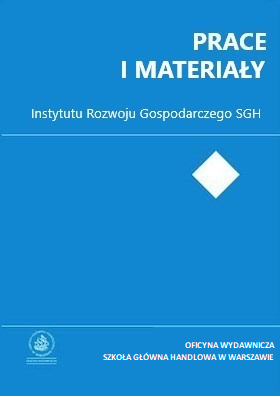Polityka pieniężna a polityczny cykl koniunkturalny
##plugins.themes.bootstrap3.article.main##
Abstrakt
W literaturze istnieje wiele teorii wyjaśniających występowanie cyklu koniunkturalnego czynnikami politycznymi. W ich ramach zakłada się, iż politycy przy wykorzystaniu narzędzi polityki makroekonomicznej próbują oddziaływać na gospodarkę. Do takich instrumentów część badaczy zalicza m.in. politykę pieniężną banku centralnego. Niniejsze opracowanie stanowi próbę analizy polityki pieniężnej z perspektywy politycznego cyklu koniunkturalnego. Formułując hipotezę o możliwości wykorzystywania przez bank centralny instrumentów dyskrecjonalnych implikujących powstawanie w gospodarce fluktuacji o charakterze politycznym, autor dokonał przeglądu teorii polityki pieniężnej ze szczególnym uwzględnieniem jej aspektów instytucjonalnych. Szczególną uwagę poświęcono również niezależności banku centralnego. W oparciu o analizę wyników badań empirycznych dotyczących możliwości wykorzystania podstawowych instrumentów polityki pieniężnej, takich jak stopy procentowe, podaż pieniądza oraz interwencje na rynku walutowym w mechanizmie kreacji cyklu, podjęto próbę odpowiedzi na pytanie, czy polityka pieniężna może stanowić podstawę działań sprawczych w zakresie politycznie motywowanych fluktuacji gospodarczych. Przeprowadzone rozważania nie dały jednak pełnej odpowiedzi na pytanie, czy banki centralne mogą być źródłem fluktuacji o charakterze politycznym. Nie udało się wykazać, iż zaobserwowane zmiany krótkookresowych stóp procentowych, wielkości agregatów pieniężnych czy kursu walutowego są spowodowane wyłącznie działaniem władz monetarnych. Z analizy badań empirycznych wynika jednak, że wahania w cyklach zbliżonych do cykli wyborczych rzeczywiście istnieją. (abstrakt oryginalny)
##plugins.themes.bootstrap3.article.details##
Bibliografia
Alesina A., Macroeconomic Policy in a Two Party System as a Repeated Game, “Quarterly Journal of Economics”, 1987, No. 102.
Barro R. J., Gordon D. B., A Positive Theory of Monetary Policy in a Natural Rate Model, “Journal of Political Economy”, 1983, No. 12.
Berger H., de Haan J., Eijfinger S. C. W., Central Bank Independence: An Update of Theory and Evidence, Working Paper, Munich, CESifo, 2000.
Berger H., Woitek U., The Geman Political Business Cycle: Money Demand rather than Monetary Policy, University of Munich, 2000.
Blaug M., Teoria ekonomii, PWN, Warszawa 1994.
Brender A., Drazen A., Where Does the Political Business Cycle Really Come From?, “Journal of Monetary Economics”, 2005, No. 52 (7).
Brunner K., The Role of Money and Monetary Policy, Federal Reserve Bank of St. Louis, 1968.
Calvo G. A., Staggered Prices in a Utility – Maximizing Framework, “Journal of Monetary Economics”, 1983, No. 12.
Clarida R. H., Gali J., Gertler M., The Science of Monetary Policy: A New Keynesian Perspective, “Journal of Economic Literature”, 1999, No. 37.
Clark W., Capital Mobility, Central Bank Independence, and Political Control of the Economy, Paper prepared for presentation at the Political Economy Workshop, Yale University, Monday, 2000.
Clark W., Hallerberg M., Strategic Interaction between Monetary and Fiscal Actors under Full Capital Mobility, American Political Science Review, 2000.
Clark W., Reichert U., International and Domestic Constraints on Political Business Cycle Behavior, International Organization, 1998, No. 57.
Cukierman A., Webb S. B., Neyapti B., Measuring The Independence of Central Banks and Its Effects on Policy Outcomes, The Word Bank Economic Review, 1992, No. 6.
DeLong J. B., “The Triumph of Monetarism?”, Journal of Economic Perspectives”, 2000, No. 14.
Dreher A., Vaubel R., Foreign Exchange Intervention And The Political Business Cycle: A Panel Data Analysis, KOF Swiss Economic Institute, ETH Zurich, 2008.
Eijffinger S., De Haan J., The Political Economy of Central-Bank Independence, Special papers in international economics, No. 19 , Princeton University, 1996.
Eucken W., „Grundsätze der Wirtschaftspolitik“, Mohr Siebeck, Tübingen 1952.
Favero C. A., Applied Macroeconometrics, Oxford University Press, Oxford 2001.
Frenkel J.A., Razin A., The Mundell – Fleming Model: A Quarter Century Later, Working Paper No. 2321, National Bureau of Economic Research, 1987.
Freyberg E., Teoria racjonalnych oczekiwań, Monografie i Opracowania, SGPiS, Warszawa 1989, nr 289.
Friedman M., The role of monetary policy, “American Economic Review”,1968, No. 58.
Friedman M., Should There Be an Independent Monetary Authority, w: Yeager L. B., In Search of a Monetary Constitution, Harvard University Press, Cambridge 1962.
Gali J., Monacelli T., Monetary Policy and Exchange Rate Volatility in a Small Open Economy, Boston College, Boston 2002.
Goodfriend M., King R. G., The New Neoclassical Synthesis and the Role of Monetary Policy – Working Paper, Richmond, Federal Reserve Bank of Richmond, 1998.
Gordon R. J., Recent Developments in the Theory of Inflation and Unemployment, “Journal of Monetary Economics”, 1976, No. 2.
Hibbs D., Political Parties and Macroeconomic Policy, American Political Science Review, 1977, No. 71.
Houben A.C.F.J., The evolution of Monetary Policy Strategies in Europe, Kluwer, Boston 2000.
Hume D., Political Discourses, Edinburgh 1752.
Humphrey T. M., Mercantilists and Classicals: Insights from Doctrinal History – Annual Report, Federal Reserve Bank of Richmond, Richmond, 1998.
Humphrey T.M., Money, Banking and Inflation, Edward Elgar, Aldershot 1993.
Kalecki M., Political Aspects of Full Employment, Political Quarterly, 1943, No. 14.
Keynes J. M., Ogólna teoria zatrudnienia, procentu i pieniądza, PWN, Warszawa 1985.
Krugman P. R., Obstfeld M., International Economics - Theory and Policy, Addison- Wesley, 2000.
Law J., Money and Trade Considered with a Proposal for Supplying the Nation with money, 1705.
Leertouwer E., Maier P., Who Creates Political Business Cycles? (Should Central Banks Be Blamed?), University of Groningen, 1999.
Long J. B., Plosser C. I., Real Business Cycles, “Journal of Political Economy”, 1983, No. 91.
Nordhaus W.D., The Political Business Cycle, “Review of Economic Studies”, 1975, No. 42.
Persson T., Tabellini G., Political Economics: Explaining Economic Policy, MIT Press, Cambridge 2000.
Phelps E. S., Phillips Curves, Expectations of Inflation and Optimal Unemployment Over Time, “Economica”, 1967, No. 34.
Phillips A. W., The relation between Unemployment and the Rate of Change of Money Wage Rates in the United Kingdom, “Economica”, 1958, No. 25.
Rogoff K., Sibert A., Elections and Macroeconomic Policy Cycles, Review of Economic Studies, 1998, No. 55.
Stadler G. W., Real Business Cycles, “Journal of Economic Literature”, 1994, No. 32.
